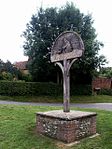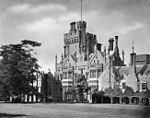Easton, Norfolk

Easton is a village and civil parish in Norfolk, England, to the west of Norwich. It covers an area of 6.25 km2 (2.41 sq mi) and had a population of 1,141 in 445 households at the 2001 census, the population increasing to 1,514 at the 2011 Census. Located close to the Royal Norfolk Showground and the A47, it also houses a campus of Easton & Otley College, a large agricultural college, in the Grade II listed 18th-century Easton Hall.The villages name means 'East farm/settlement'. The Grade I listed Church of England parish church of St Peter stands at the west end of the village, near the roundabout at the end of the southern Norwich bypass. It is built mainly of flint, rendered in part, with stone dressings. Restored in the 1880s, it dates from the late 12th century with additions made in the 13th and 15th centuries. The tower collapsed in the 18th century. The south doorway is 12th century and the marble font dates from about 1200. Easton was the birthplace of the 14th century Cardinal Adam of Easton, who was imprisoned in Italy for conspiring against Pope Urban VI and spared execution through the intervention of King Richard II.The village's football team, Easton FC, currently plays in the Anglian Combination.
Excerpt from the Wikipedia article Easton, Norfolk (License: CC BY-SA 3.0, Authors, Images).Easton, Norfolk
Marlingford Road, South Norfolk
Geographical coordinates (GPS) Address Nearby Places Show on map
Geographical coordinates (GPS)
| Latitude | Longitude |
|---|---|
| N 52.653 ° | E 1.156 ° |
Address
Marlingford Road
NR9 5DL South Norfolk
England, United Kingdom
Open on Google Maps








